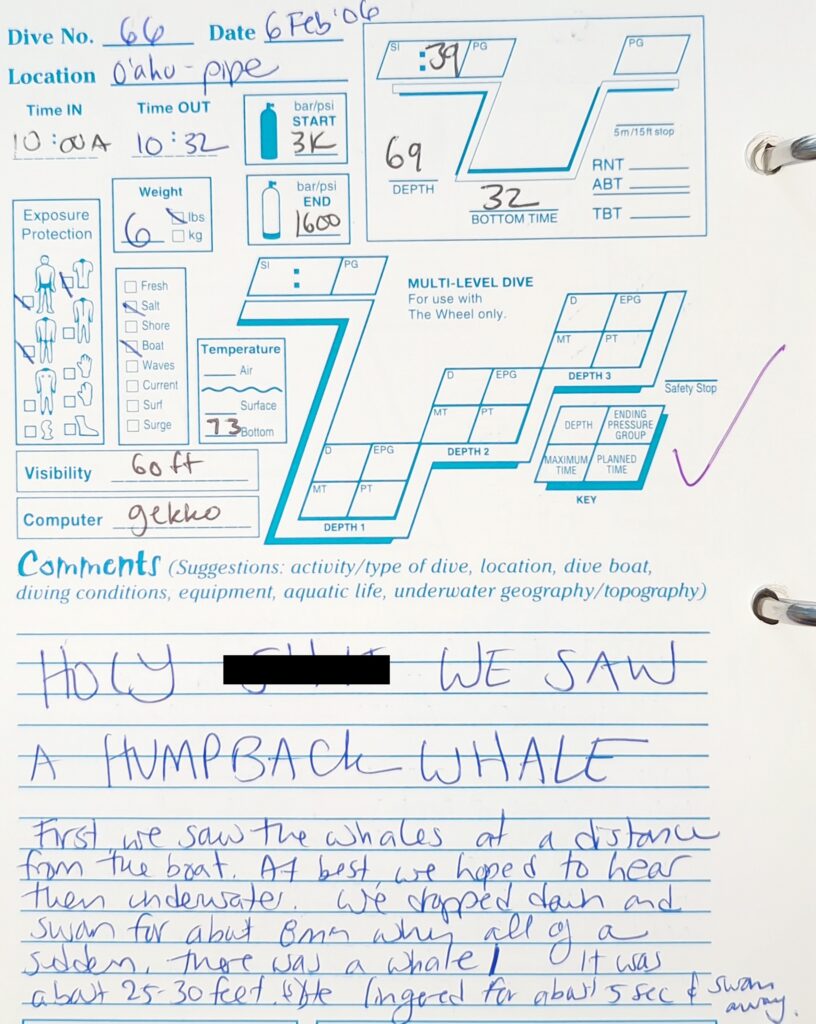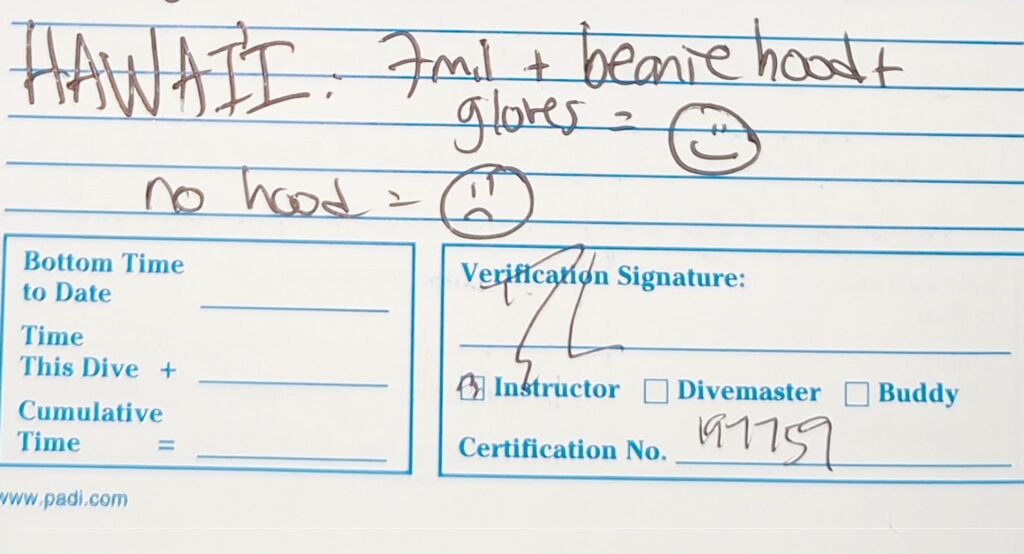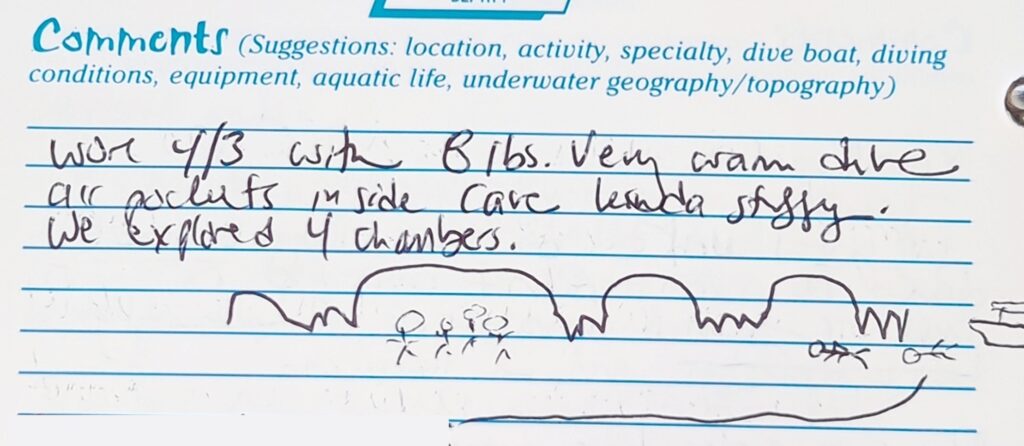This article will describe how to log a dive and explain why you should maintain a record of your diving experience. When logging a dive, you can include a lot of information or just a few basic details. Read on to learn which sections I always fill in, which ones I usually skip and why.
3 Reasons to Keep a Dive Log
There is no rule that says you have to log every dive, but it only takes a couple of minutes to record a few details. Down the road, you’ll be glad you did. Here’s why:
#1 Proof of Experience – Some of the world’s most memorable and breathtaking dive sites aren’t open to beginner divers. Whether you want to dive between two continents in Iceland, hook in at Blue Corner in Palau, or dive with giants in Socorro — the dive operator will ask you to prove you’re qualified.
Even beginner-friendly destinations may ask for proof of recent diving experience. If you don’t have a logbook, you may be asked to do a scuba refresher class or end up in a group of less-experienced divers.
In addition, many PADI courses have logged dive requirements. Want to become a Divemaster? You’ll need at least 40 logged dives to start the course. Or would you rather become a PADI Self-Reliant Diver? That specialty course requires 100 dives as a prerequisite.
#2 Be Prepared (and Comfortable) – Water temperatures can vary widely depending on the time of year, 15°F/9°C swings are not uncommon. You might prefer a 7mm with a hood and gloves during winter months and a 5 mm in the summer. The amount of weight you need will also vary with the water temp and your exposure protection. Your log book works as an equipment diary, so you don’t have to guess how much lead to ask for.
Even if you only dive in tropical environments, a dive log can be useful. For example, after day three on a liveaboard, I get cold faster and need a hood. I also keep notes about how much seasickness medication I take. Over time, I discovered I don’t need to take half a pill every day. I can dial back to a quarter pill after being at sea for a few days.
#3 Track Critter Sightings – The first time I saw humpback whales while diving in Hawai’i, it was a fluke (pun intended). The second time I saw them, I planned my Hawai’i trip for the same time of year as the previous one. As the saying goes, “Luck favors the prepared.”

How to Fill Out a Dive Log — The Essential Details
Whether you use an online dive log or a paper logbook, there are certain pieces of information you’ll always want to fill in.
When and Where
✔ Date of Dive
✔ Dive Site Name/Location
Record the date (day, month and year) to prove you’ve been diving recently. Note the dive site name and location as proof of experience. For example, Punta Sur/Devil’s Throat is a well-known site in North America that is both deep and involves diving in current. If I see that site in someone’s logbook, I know something about them as a diver.
Also, if you dive long enough, you’ll end up diving two dive sites with the same name, “The Arch” and “Bird Rock” are two examples of common dive site names. Similarly, you might dive the same site twice in one visit. You could differentiate the dives by adding a title such as, “Black Rock, Maui – Night Dive.”
Proof of Experience
✔ Buddy Signature (dive logs must be signed to be valid)
✔ Dive Number
In Case There’s Trouble
✔ Total Bottom Time
✔ Max Depth
✔ Surface Interval (if applicable)
Accidents can happen. If they do, the dive medical professionals at DAN or the local chamber will ask for the info above.
For Future Reference
✔ Exposure Protection (wetsuit or drysuit, hood, gloves)
✔ Weight (amount and distribution)
✔ Cylinder Type and Size
✔ Additional Equipment (camera, scooter, rebreather, etc.)
✔ Comments (critters you saw, bad drawings)

Full disclosure: I own my own scuba gear and I don’t record every detail when I’m diving my usual configuration (5mm wetsuit, aluminum 80/11-liter tank, no additional equipment). I only note when I use something different, a steel 63 tank instead of an aluminum 80, for example (because an aluminum 80 tank is 4-5 lbs/2 kg positive at 500 PSI/50 Bar and a steel 63 is only 0.7 lbs/317.5 g positive at 500 PSI/50 Bar).
How to Fill Out a Dive Log — Bonus Info
If I’m on a tropical dive trip, I typically write a detailed dive log following the first dive then skip details like how I accessed the site, water temp, etc. if it’s the same for subsequent dives. I do, however, like to record my air consumption and get the dive shop/liveaboard stamp.
Good to Know
- Air Temp, Surface Temp, Temperature at Depth
- Visibility
- How Did You Access the Site* (boat, shore, helicopter, etc.)
- Conditions
- Breathing Gas (air, EANx32, EANx 36, etc.)
- Bar/PSI at Start and Finish
Nice to Have
- Dive Shop or Instructor Stamp
- Body of Water (ocean, lake, quarry, river, controlled environment, other)
- Cumulative Bottom Time
- Pressure Group at Start/Finish (only if you’re using an eRDPML or dive tables)
- Time In/Time Out
- Descriptive Title*
*Required if logging a dive on padi.com

How to Fill Out a PADI Dive Log
When I got my first scuba certification, paper logbooks were the only option. Now, many divers use a dive log app or some other form of digital logbook. If you received a PADI certification in recent years, you might already have a few dives in the online dive log included with your PADI account. Here’s how to log your dives on padi.com or with the PADI AppTM (available for Apple and Android devices).
How to Log a Dive on PADI.com
- Log in
- Click on your name in the top right
- Choose “Logbook” from the menu
- Fill in dive details
- (Optional) upload photos
How to Log a Dive on the PADI App
- Log in
- Click on “Logbook”
- Click the blue + sign in the top right corner
- Fill in dive details
- (Optional) upload photos
Tips If You Use a Paper Logbook
Some divers are surprised to see me filling out a paper logbook. But I love flipping through the pages and remembering past diving adventures. I laugh at my crude fish drawings and stern notes-to-self (“NEXT TIME, BRING A HOOD!”) and feel a sense of pride at how far I’ve come as a diver.

That said, I don’t bring my entire logbook with me when I travel. I leave the binder at home and only bring:
- The five most recent logbook pages and (if necessary) pages showing relevant experience
- Twice the number of blank pages I think I’ll use (sometimes I make mistakes)
- A plastic sleeve with my DAN card, PADI certification card and dive computer instruction manual





